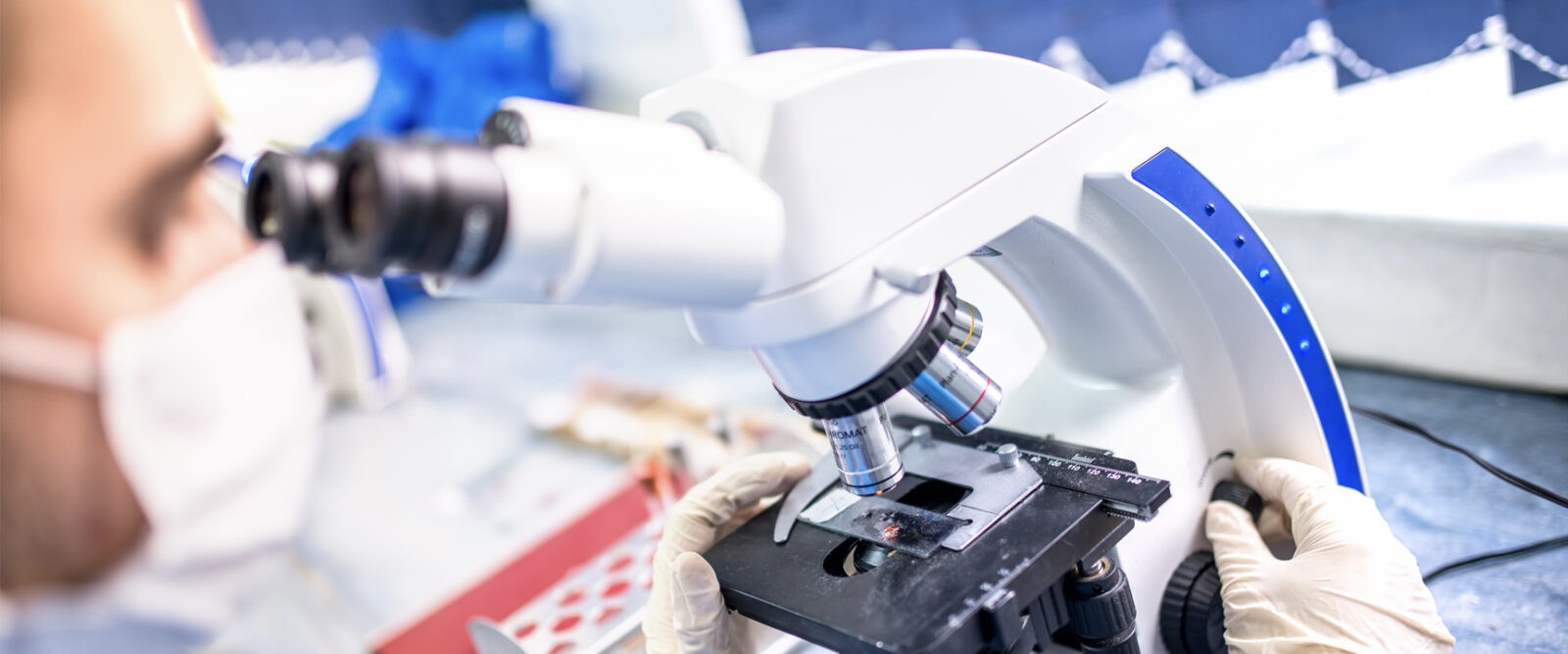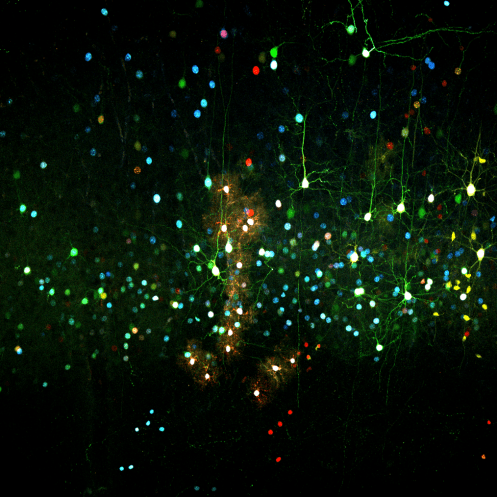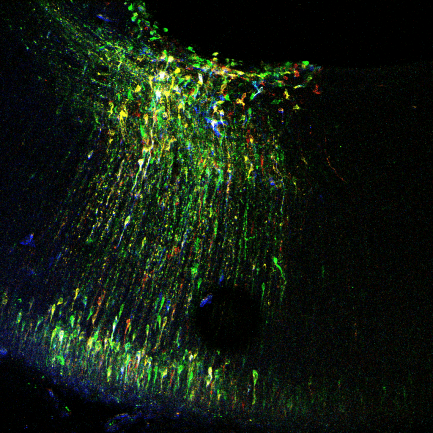LABORATORIES
The olfactory system and its development
The olfactory system and its development
Research
Team
Publications
Contact
Others
Research
Our overall goal is to trace the progeny of individual progenitor cells in the mouse brain, in order to understand both their fate and lineage.

Lines of investigation
The research lines of the laboratory are:
- Clonal analysis of neural progenitors in mouse olfactory system and cortex.
- Analysis of the identity and functionality of cells within a clone.
- Final dispersal pattern of different lineages
- Heterogeneity of NG2 cells in adults
- Determination of the existence of astroglial functional domains.




Contributions from our group:
- Clonal dispersal of NG2 cells, describing the formation of large clones (up to 400 cells) in adult brain.
- Generation of a method for clonal analysis of the different glial populations (StarTrack), demonstrating that development plays a fundamental role in determining astrocyte heterogeneity.
- Characterization of astroglial populations related to the migration of BO interneuron precursors.
- Correlation between the formation of olfactory glomeruli with the generation of synapses in the OB at different stages of embryonic development.
- Stages of morphogenesis of projection cells of the BO in relation to the formation of glomerular structures.
Experimental approaches
- Electroporation after injection of transposable vectors intrautero and in early postnatal animal (StarTrack).
- Experimental embryology using ultrasonic echography.
- Confocal and time-lapse microscopy.
- Cell and organotypic cultures.
- Co-cultures of explants in collagen networks.
- Gene probe synthesis, in situ hybridization, vector construction.
- Overexpression-repression of genes using retro- and lenti-viral technology.
- Immunohistochemistry.
- Classic histological methods: Golgi method.
Team

Laura López de Mascaraque
Principal Investigator
Publications
Publications of the last 10 years
- Bribián, A, Pérez-Cerdá F, Matute C, & López-Mascaraque, L. 2018. Clonal Glial Response in a Multiple Sclerosis Mouse Model. Front Cell Neurosci. 12:375.
- Tiwari N, Pataskar A, Péron S, Thakurela S, Sahu SK, Figueres-Oñate M, Marichal N, López-Mascaraque L, Tiwari VK, Berninger B. 2018. Stage-Specific Transcription Factor Drive Astrogliogenesis by Remodeling Gene Regulatory Landscapes. Cell Stem Cell. 23-4, pp.557-571.
- Cerrato V, Parmigiani E, Figueres-Oñate M, Betizeau M, Aprato J, Nanavaty I, Berchialla P, Luzzati F, de’Sperati C, López-Mascaraque L, Buffo, A. 2018 A. Multiple origins and modularity in the spatiotemporal emergence of cerebellar astrocyte heterogeneity. PLoS Biol., 16(9):e2005513. doi: 10.1371/journal.pbio.2005513. eCollection 2018 Sep
- García-Marqués, J. and López-Mascaraque, L. 2017. Clonal mapping of astrocytes in the olfactory bulb and rostral migratory stream. Cerebral Cortex 27 (3), 2195-2209
- Figueres-Oñate, M. García-Marqués, J. & López-Mascaraque, L. 2016. UbC-StarTrack, a clonal method to target the entire progeny of individual progenitors. Scientific Reports, 6:33896. doi: 10.1038/srep33896
- Martínez-Marcos, A., Trejo, J.L. and Lopez-Mascaraque, L. (2016) Editorial: 50th anniversary of adult neurogenesis: Olfaction, hippocampus, and beyond. Frontiers in Neuroscience, 31
- Figueres-Oñate & López-Mascaraque. 2016. Adult olfactory bulb interneuron phenotypes identified by targeting embryonic and postnatal neural progenitors. Frontiers in Neuroscience doi:10.3389/fnins.2016.00196
- De Castro, F. and López-Mascaraque, L. 2016. Olfactory system embryonic development. In: Kaufman’s Atlas of Mouse Development Supplement, 1st Edition. Editors: Richard Baldock, Jonathan Bard, Duncan Davidson & Gillian Morriss-Kay (eds.). Elsevier, pp. 275-28
- Bribián A, Figueres-Oñate M, Martín-López E, López-Mascaraque L. 2016. Decoding astrocyte heterogeneity: New tools for clonal analysis. Neuroscience. 323, 26:10–19
- Parmigiani,E., Leto, K., Rolando, C., Figueres-Oñate, M., López-Mascaraque, L., Buffo, A. and Rossi.F. 2015. “Heterogeneity and bipotency of astroglial-like cerebellar progenitors along the interneuron and glial lineages”. Journal of Neuroscience 35 (19), 7388-7402
- Figueres-Oñate M, García-Marqués J, Pedraza M, De Carlos JA and López-Mascaraque L (2015). Spatiotemporal analyses of neural lineages after embryonic and postnatal progenitor targeting combining different reporters. Front. Neurosci. 9:87. doi: 10.3389/fnins.2015.00087
- Figueres-Oñate M, Gutiérrez Y, López-Mascaraque L. 2014. Unraveling Cajal’s view of the olfactory system. Front Neuroanat, 8:55. doi: 10.3389/fnana.2014.00055.
- García-Marqués J, Núñez-Llaves R, López-Mascaraque L. 2014. NG2-glia from pallial progenitors produce the largest clonal clusters of the brain: time frame of clonal generation in cortex and olfactory bulb. J Neurosci, 5;34(6):2305-13.
- Martín-López E, García-Marques J, Núñez-Llaves R, López-Mascaraque L. 2013. Clonal astrocytic response to cortical injury. PLoS One,10;8(9):e74039.
- López-Mascaraque L, Trejo JL. 2013. From the nose to the brain: olfaction and neuroscience. Anat Rec (Hoboken), 296(9):1285-6.
- Gire, D.H., Restrepo, D., Sejnowski,T.J. Greer, C., De Carlos,J.A. and Lopez-Mascaraque, L. 2013 Temporal Processing in the Olfactory System: CanWe See a Smell?. Neuron, 78:416-432.
- García-Marqués and López-Mascaraque, L. 2013. Clonal Identity Determines Astrocyte Cortical Heterogeneity. Cerebral Cortex, 23:1463–1472.
Contact
Where to find us
The olfactory system and its development laboratory
Instituto Cajal CSIC. Avda. Doctor Arce, 37. 28002. Madrid
Call us
Phone
Write us
Email address
Others
Doctoral Thesis
- Maria Figueres Onate.
Clonal analysis of neural progenitors.
Faculty of Medicine, Autonomous University of Madrid. October, 2016. - Jorge Garcia Marques.
Ontogeny of astroglial heterogeneity and its role in postnatal migration to the olfactory bulb.
Faculty of Medicine, Autonomous University of Madrid. March 2012. - Albert Blanchart Aguado
Spatio-Temporal Analysis of Olfactory Glomerulus Development: Morphogenesis and Cellular Interactions
Biological Sciences Faculty. Complutense University of Madrid. September 2008. - Conception Garcia Garcia.
Identification, characterization and development of olfactory structures in mutant mice for the Pax-6 gene.
Biological Sciences Faculty. Complutense University of Madrid. October, 2004.
Books, monographs and collective volumes
- López-Mascaraque, L. 2006. La vía olfatoria: El error de Cajal. Publicado en: Perspectivas sobre Cajal y su obra: 100 años después. Editores: Ferrus & Gamundi. Editorial Pirámide – Universidad de las Islas Baleares.Pp. 213-233.
- García-Marqués, J., Blanchart, A. y López-Mascaraque, L. 2006. Construyendo un bulbo olfativo. Publicado en: La Olfacción en España. Editorial: SBI, SL. Editores: Alonso, De Castro & López-Mascaraque. Pp.55-69.
- Valverde, F., De Carlos, J.A. and López-Mascaraque, L. 2002. The Cerebral Cortex of Mammals: Diversity within unity. In: Cortical Areas. Unity and Diversity. Published by: Taylor & Francis, London, New Cork (A. Schüz and R. Miller, eds.) pp 195-217.
Science dissemination
- Laura López-Mascaraque and José Ramón Alonso 2017.
Collection What we know about..
Publisher: CSIC and Catarata, pp. 127. ISBN: 978-84-00-10178-7. - Smell workshops: “Smell and taste with the brain.” Organized by the ROE and CSIC.
Sponsored by FECYT.
Collaborations
- Arturo Alvarez-Buylla. Department of Neurological Surgery, University of California, San Francisco, USA.
- Benedikt Berninger. University Medical Center, Johannes Gutenberg, University Mainz, Germany
- Analissa Buffo. Department of Neuroscience Rita Levi-Montalcini, Neuroscience Institute Cavalieri Ottolenghi (NICO), University of Turin, Italy.
- Magdalena Gotz. Helmholtz Zentrum München, Munich, Germany
- Guillermina López-Bendito. Instituto de Neurociencias, Alicante
- Carlos Matute. Achucarro Basque Center for Neuroscience, Bilbao
- Peter Mombaerts. Max-Planck Research Unit for Neurogenetics. Frankfurt, Germany

Neuroscience Research Center dependent on the CSIC. Founded in 1920 and initially directed by Santiago Ramón y Cajal. World reference in the study of the brain. Custodian of the Cajal Legacy.
Activities
